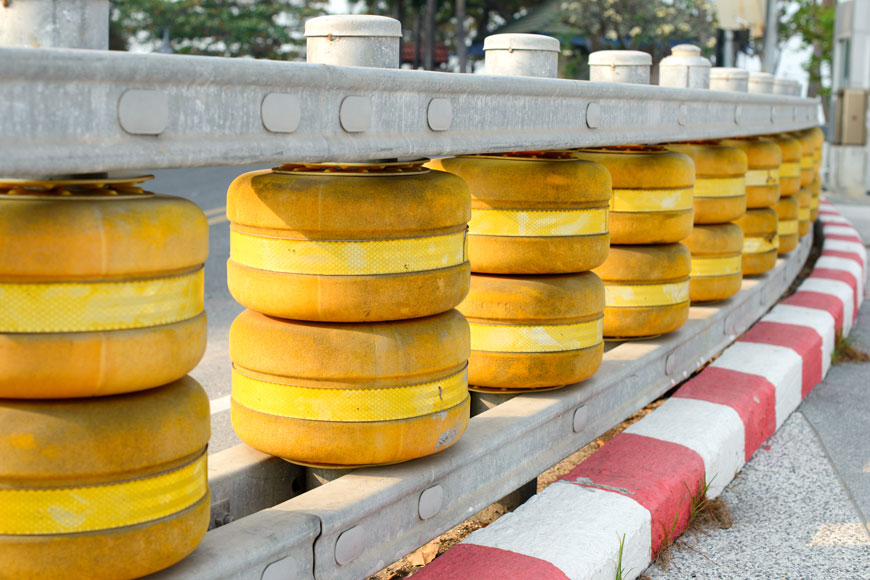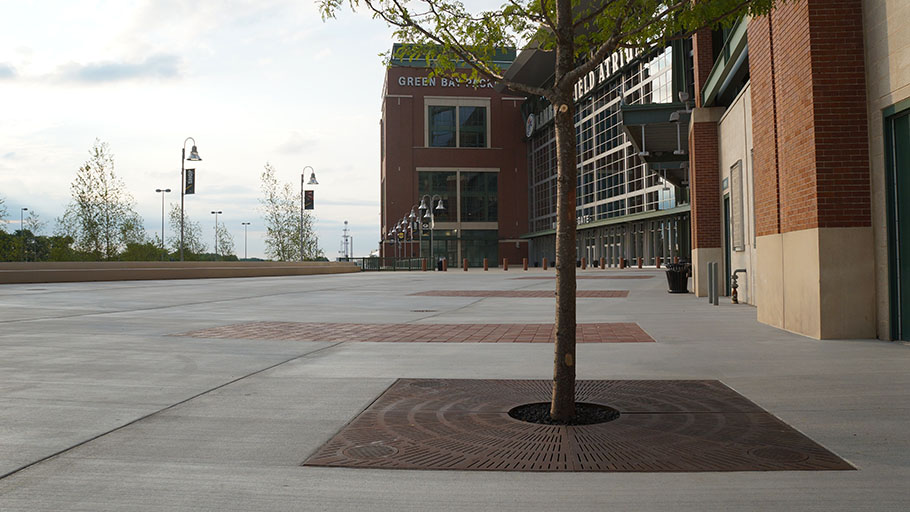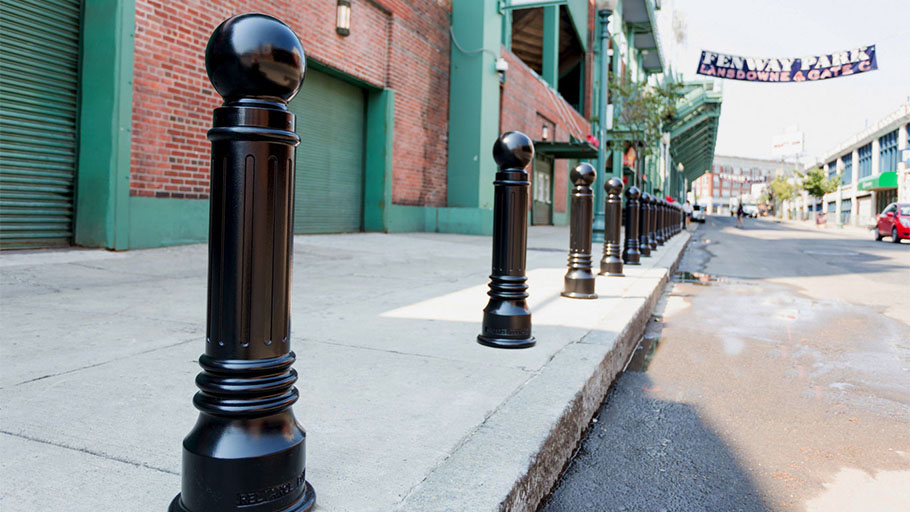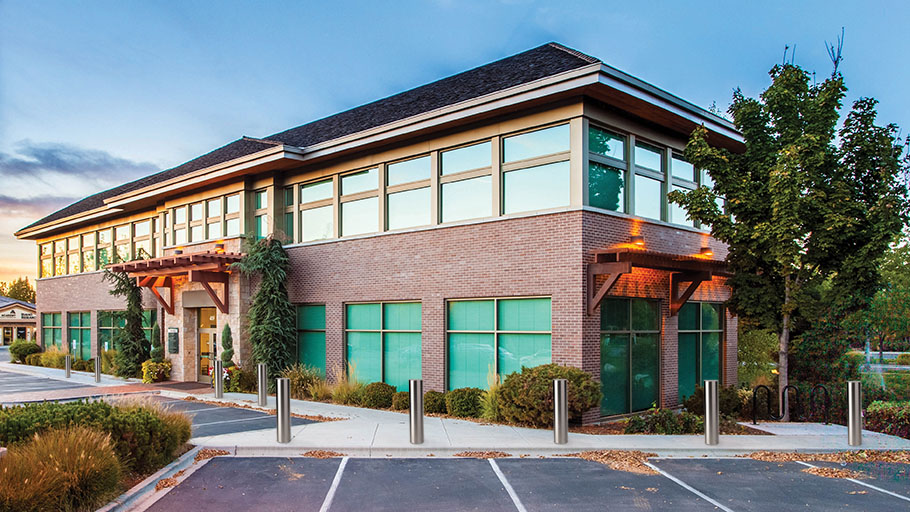High-speed crash testing is different on highways from streets (comparing ASTM and NCHRP standards)

Roads and cars are engineered for safety. Standards make sure that performance is the same regardless of the manufacturer. In order to specify new products coming to market, a series of standards exist that describe the stopping power of various barriers and boundaries—yet there exists more than one standard to evaluate crash barriers. ASTM low- and high-speed, K-Rated, NCHRP 350, MASH 2009ASTM: this guide will demystify the standards used to rate crash-barriers.
What are crash barriers?
In Britain, “crash barrier” often specifically refers to the metal guardrails found on highway medians. In general usage, the term is used to mean any barrier designed to stop vehicle momentum, whether accidental or intended.
Anti-ram barriers vs. crash attenuation barriers
Crash barriers are tested to stop vehicle incursion. Different types of incursion have led to two main testing standards. Barriers built explicitly to protect perimeters from head-on crashes are often called “anti-ram” barriers. Those built to mitigate accidents on are often called “crash attenuation” barriers. Form, function, and placement usually dictate what testing is done, even if some of the crash attenuation barriers might work in anti-ram scenarios, and vice versa. It’s not just the physics of stopping a vehicle in motion that matters. The barrier must be appropriate to its context.

Anti-ram barriers, K-Ratings, and ASTM certification
Anti-ram barriers are crash barriers installed against head-on intrusion. Bollards, fences, wedge barriers, and drop beams are common anti-ram barriers. Many of these are engineered to work as anti-terrorist barricades. The strongest are designed to stop a heavy-duty attacking vehicle, possibly carrying an explosive payload, from getting to the wall of a building or to a line of pedestrians.
To judge how effective the barrier might be, the Department of Defense developed a “K-rating” system in the 1980s. Major government buildings used these K-ratings as a guide when creating perimeter defenses.
Soon, engineers and site planners saw the utility of anti-ram barriers for more commonplace scenarios. Barriers with vehicle stopping power are a useful safety measure from everything from preventing smash-and-grab robberies to protecting utilities boxes. Every day, an average of 60 vehicles crash into storefronts, causing serious injury and property loss. Engineers quickly adapted anti-ram barriers of different vehicle-stopping power as useful against accident as much as terrorist attack.
As anti-ram barriers became increasingly civilian, ASTM International (American Society for Testing and Materials) began to test and certify their stopping power, taking over from the Department of Defense. There are two major ASTM standards available, for high-speed and low-speed crashes.

Crash standards: ASTM F2656 and ASTM F306
Low-speed crash standards are laid out in ASTM F306 / F3016M. This protocol tests the stopping power of a barrier against a 5000-lb vehicle at 10–30 mph. The low-speed standard is less commonly referenced than ASTM F2656 / F2656M, the “Standard Test Method for Crash Testing of Vehicle Security Barriers.” ASTM F2656 is used for such barricades as bollards, drop beams, wedges, and security fences.
When testing barriers for stopping power, the ASTM protocol assigns a base rating and a penetration rating. The weight and speed of the test vehicle are encoded in the base rating. The penetration rating shows how far past the crash barrier the test vehicle’s chassis manages to infiltrate.
Vehicle weights tested are small passenger vehicle, pickup truck, medium duty truck, and heavy-duty truck. These can be tested at 30–60 mph. Penetration ratings start at P1, less than 3.3 ft ingress, and this is generally accepted to be the “passing” standard for each speed rating.

A crash attenuator is tested for the shallow-angle impact common on highways.
Crash attenuation barriers
The DoD’s research towards stopping concerted, coordinated vehicle attack set the basis of later ASTM testing.
In parallel, the engineers who create and maintain the highway system were also creating standards to dispel and contain vehicle impact forces.
In highway terms, crash barriers are known as “crash attenuators.” Highway guardrails, fences, cushions, and barriers are built with the knowledge that roadway accidents are inevitable. Crash attenuators are meant to reduce the severity of these accidents. They might protect infrastructure, like bridge supports; redirect vehicles, like medians; or protect work zones, like crash-trucks.
Crash attenuators work to reduce the overall destruction by cushioning, slowing, or redirecting vehicle crash energy. Various types of attenuators are optimized to work in different ways. Stopping power is not necessarily the only factor to evaluate. Reducing the damage of shallow-angle crashes, like those along a highway median, may mean slowing rather than abruptly stopping the car: for example, many barriers are shaped to prevent tires from catching a post, so that the vehicle slows rather than stops abruptly. Engineering tests may examine the likelihood of rollover. Where ASTM crash-rated barriers focus on short range stopping power, the desired behavior for a crash-rated highway barrier is context specific.
In 1993, the NCHRP, or National Cooperative Highway Research Program, released a set of procedures for evaluating the safety performance of highway barriers. This report, called the NCHRP 350, became the standard testing procedures for highway crash barriers. These are still commonly referenced, although the American Association of State Highway and Transportation Officials released an updated standard called “Manual for Assessing Safety Hardware” (MASH) in 2009.

MASH and NCHRP 350 Attenuator types
The desired behavior of an attenuator can be described as re-directive or not, and gated or not.
- Non-re-directive: The vehicle won’t be redirected when crashing into the barrier. For attenuators, this could mean a crash cushion or some other energy absorbing system. Impact-protective bollards are also often non-re-directive crash barriers.
- Re-directive: The vehicle will be redirected by the barrier. Energy is captured and diverted, perhaps back into a lane or into a clear zone. Bell and Martello bollards are re-directive.
- Gating: The vehicle will go through on head-on impact, often redirected into a “clear zone,” away from greatest damage. Non-gating barriers slow and sometimes redirect the impact.
- Non-gating: The vehicle won’t go through on head-on impact. ASTM crash-rated vehicle barriers are all gating. Vehicles impacting at a steep angle will come to a full stop, sometimes to great destruction of the vehicle.
Crash attenuation: vehicle weights and testing levels
Different testing levels in highway crash testing examine a barrier’s behavior when impacted at different speeds from different sizes of vehicle. One of the main ways that MASH updated standards was to recognize that vehicle weights and bumper heights have changed since 1993; testing levels now must reflect modern vehicle standards.
Testing levels are granted for different vehicle weights at different speeds and angles of crash.
- TL-0 and 1 are for work zones and low speed roads
- TL-2 is for residential or local roads
- TL-3 is for high-speed arterials
- TL-4 and above are ratings to manage heavy vehicle impact, often needed on highways
When comparing the NCHRP 350 and MASH standards, it’s important to remember that the vehicle weights have changed between the two standards.

Comparing crash barrier standards: K-Ratings, ASTM crash barriers, NCHRP 350, and MASH 2009
When evaluating crash barriers, the standard to use is based on the primary purpose of the barrier.
Are the barriers meant to be a perimeter protecting pedestrians, cyclists, or buildings? Is head-on impact the most likely scenario? Are the settings human-scaled and need pedestrian access?
Barriers in these situations are generally evaluated as to how far they allow a vehicle to penetrate past them. They protect against purposeful attack and head-on accidents. In most of these cases, the focus is on preserving the safety outside the vehicle in the relatively cramped conditions of busy streets near major buildings. As a defensive standard, the ASTM crash ratings, which replace K-ratings, are the ones to rely on.
Or are the barriers meant to protect on highways, minimizing the severity of shallow angle crashes and acting to maximize safety inside and outside the vehicle? In these cases, it’s the MASH standards, which replace NCHRP350 test levels, to rely on.
In either case, evaluating the likely speed and weight of traffic is important. What types of crashes are possible? What forces need to be mitigated, in which direction? Answering these questions allows an engineer to find the product perfectly designed for their situation.












